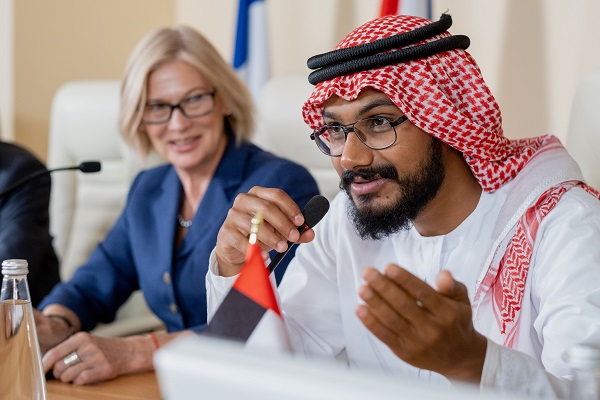How is Art Used to Hide Money Laundering?
Well, it would not be right to say all art dealers are criminals, but the art sector is prone to money laundering because of the enormous transition sizes, subjective prices, and preference for cash payments. Art dealers need privacy for security reasons, but the government needs to be proactive in tackling the severe issue of money laundering using art. Dubai is a famous city and one of the seven emirates and is a renowned business hub open to individuals and businesses from across the globe.
The art market is prone to misuse by criminals. The UAE market has implemented the AML law made by FATF- Financial Action Taskforce to strengthen the UAE government to combat the challenges of financial terrorism and prevent money laundering. The anti-money laundering laws in the UAE help businesses to identify suspicious customers and detect financial fraud early in the customer screening process.

• Screening should be done on risk scoring method considering different factors such as -if the sale details are in the public domain and the type of artwork the business deals in.
• Identification of Politically exposed persons (PEP) through an AML Screening Process.
• Businesses can identify the UBO- Ultimate Beneficial Owner using transaction monitoring software. Financial institutions can determine suspicious nature and inform them about the risk of business relationships with such individuals and entities.
• Institutions need to focus Special attention on the Source Of Wealth (SOW) and Source Of Funds (SOF).
• Institutions should also concentrate on dealers, galleries, and auction houses to ensure that they are screened per the KYC program. The program will help bring more transparency to the transaction and mitigate risks. The transactions, therefore, are more transparent, and there’s less probability of any suspicious transaction.
• Verifying SOW and SOF: SOW includes activities that include the total net worth, while the SOF involves the money used for facilitating transactions between the FI and the client. Money laundering has become a massive issue in the UAE, and the government is taking strict actions to prevent the problem from spiralling. It is essential to record the SOF details when the customers open an account. If the SOF includes sales of an artwork, then receipts for relevant pieces of art should be gathered.
• The AML team will analyse if the artwork’s price is reasonable and not exaggerated or inflated to facilitate money laundering. They also need to verify the invoice provided – if it’s real or not and detect any suspicious activity. They can take the help of the Art Loss Registry, and the art databases can shed light on the same.
UAE Laws to Prevent Money Laundering
The UAE government takes some decisive actions with strict AML- Anti-money laundering laws. The government has passed two laws – AML- Anti Money Laundering (law no- 4/2002) and CFT- Counterterrorist financing (Law No- 1/2004). The law states the penalties for the crimes, including life imprisonment the death penalty. As per the law, assets can be forfeited and seized.
Training
Training is required for AML professionals to make them acquainted with the art market and the different techniques and methods used by criminals to hide money laundering behind the art. This will help them to equip themselves with updated knowledge, better skills, and proactiveness to identify and deal with suspicious activities.
AML Training helps them be acquainted with the mode of operations of the art market, the type of artwork traded, and the source of the procurement of artwork. They also need to gather information about the dealers and how the purchase and sale process is carried out. In UAE, the regulation Conferencing procedures for AML requires financial institutions to create and execute the AML/ CFT training programs to prevent criminal activities.

Conclusion
The authorities are making every effort to combat money laundering and financial terrorism and regulate the art market. It will deter criminals from using art as a vehicle for money laundering. AML UAE is one of the highly acclaimed professional firms in the UAE rendering Anti-Money laundering services such as AML/ CFT Policy Controls, and procedures documentation, AML Training, AML software selection,In-house AML Compliance Department setup, Annual AML/ CFT Risk Assessment report, and AML/ CFT health check-up. Individuals/ businesses can take professional assistance to help prevent the now frequent money laundering cases. Feel free to visit AMLUAE for more information.
Our recent blogs
side bar form
Add a comment
Share via :
FAQs
Yes, art can be used for money laundering. It is easy to smuggle or hide art. Also, the prices of art pieces are subjective and can be manipulated. So, it is easier to launder money by buying and selling art. Money launderers buy art with illegal funds and then sell it in private transactions to get legal money.
Art is used for money laundering because art prices are not fixed. They are subjective and hence, subject to manipulation. Also, it is easier to fool people with fake art showing them as authentic pieces with high value. Other reasons include lack of regulations, anonymity, and transportability.
Not always. But it is one of the most common ways to launder money.
The trading (buying and selling) of art uses money.
The link between art and money is that art is bought and sold using money. When an art dealer sells an art piece to a buyer, they get money from selling art.
Money launderers have illicit money with them. They buy art pieces with that money. Then, they sell those art pieces and, in exchange, get legal money. Another way is to take up a loan from a bank using those art pieces as collateral. Thus, their illicit money becomes legal.
About the Author
Pathik Shah
FCA, CAMS, CISA, CS, DISA (ICAI), FAFP (ICAI)
Pathik is a Chartered Accountant with more than 25 years of experience in compliance management, Anti-Money Laundering, tax consultancy, risk management, accounting, system audits, IT consultancy, and digital marketing.
He has extensive knowledge of local and international Anti-Money Laundering rules and regulations. He helps companies with end-to-end AML compliance services, from understanding the AML business-specific risk to implementing the robust AML Compliance framework.




